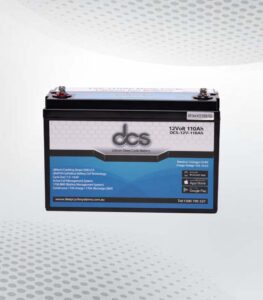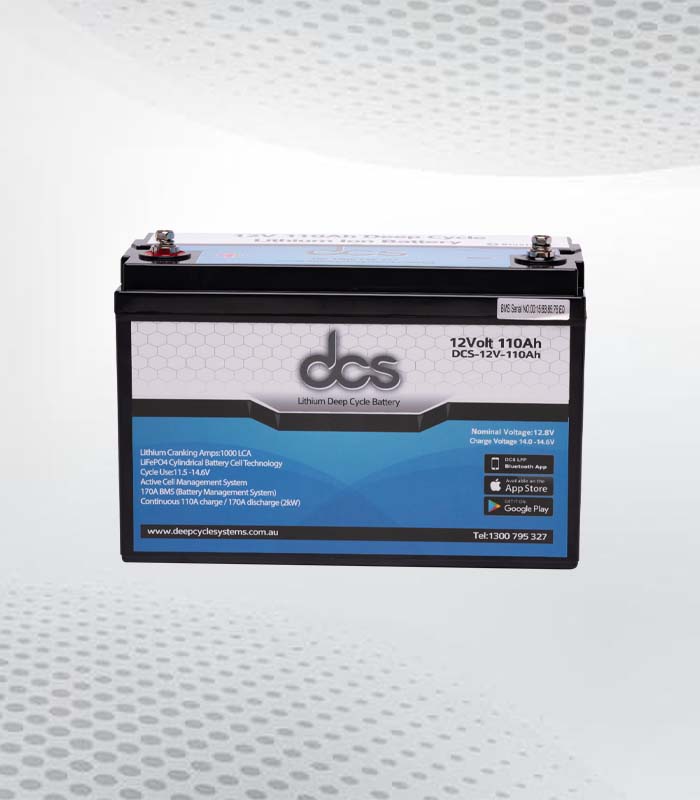In the world of portable power sources, the 100 amp lithium ion battery stands out as a true powerhouse. With its high capacity and efficient energy output, this battery has become a popular choice for a wide range of applications. In this blog post, we will delve into the ins and outs of the 100 amp lithium-ion battery, exploring its benefits, maintenance requirements, environmental impact, and future potential.
Understanding the Basics of the 100-Ah Lithium-Ion Battery
A 100 amp lithium-ion battery operates through the movement of lithium ions between the cathode and anode during charge and discharge cycles. This type of battery is characterised by a significant energy storage capacity, as denoted by its “100 Ah” rating, meaning it can deliver 100 amperes of current for an hour under ideal conditions. This energy capacity is a result of the battery’s specific chemical composition and the efficient lithium ion technology it utilises.
These batteries stand apart due to their high energy density – a trait allowing them to pack a substantial amount of energy in a limited space. This feature is particularly advantageous in applications where spatial constraints are a concern, such as in modern electric vehicles or compact, portable electronics.
The operational mechanism of lithium ion batteries involves the flow of ions through an electrolyte from the anode to the cathode during discharging, and in the opposite direction when charging. This flow is facilitated by the unique properties of the lithium ions, which contribute to the battery’s overall efficiency and performance.
In terms of structure, the battery comprises several cells connected in series or parallel configurations to achieve the desired voltage and capacity. Each cell includes an anode, cathode, separator, and electrolyte, with lithium compounds in the electrodes playing a pivotal role in the battery’s functionality. This intricate design and chemical composition underpin the 100-Ah lithium-ion battery’s robust performance, positioning it as a cornerstone in the advancement of portable power solutions.
The Advantages of Using a 100Ah Lithium Battery
The primary benefit of employing a 100Ah lithium battery is its exceptional energy density, which ensures a substantial amount of power is stored within a notably compact framework.
This characteristic is particularly beneficial in scenarios where space is at a premium, such as within electric vehicles or handheld electronic gadgets. Moreover, these batteries boast a remarkable longevity and minimal maintenance needs, which translates to a cost-efficient and dependable energy solution over time.
Another advantage is their capability to endure a high number of charge and discharge cycles with minimal degradation, which significantly extends their usable life compared to traditional battery technologies. This resilience contributes to their cost-effectiveness, as the need for frequent replacements is substantially reduced. Lithium-ion batteries also have the advantage of a relatively low self-discharge rate, meaning they retain their charge for longer periods when not in use, thereby ensuring readiness for application whenever required.
Furthermore, the versatility of 100-Ah lithium-ion batteries is evident in their broad operating temperature range, making them suitable for a diverse array of environmental conditions. This adaptability enhances their reliability as a power source in varying climates and usage scenarios.
Additionally, their rapid charging capabilities enable quicker replenishment of energy, thus supporting applications demanding swift turnaround times and high operational efficiency. This set of advantages underscores the growing preference for lithium-ion batteries across numerous sectors, highlighting their pivotal role in the evolution of modern energy storage solutions.
Maintenance and Safety Considerations
Ensuring the longevity and safe operation of a 100 amp lithium-ion battery requires adherence to certain guidelines and practices. Firstly, it’s crucial to maintain the battery in a controlled environment, steering clear of extreme temperatures which can precipitate wear or compromise safety.
Proper charging practices are essential; this involves using only the charger specified by the manufacturer and avoiding pushing the battery beyond its recommended charge limits. Overcharging or deep discharging can lead to diminished battery performance and, in some cases, hazardous situations.
Monitoring the battery’s health is another pivotal aspect. Regular checks on the battery’s temperature and voltage can pre-empt potential issues, safeguarding against overheating and electrical malfunctions. Should the battery exhibit any unusual behaviour, such as excessive heat generation or swelling, it is advisable to cease usage immediately and consult a professional.
Protective measures should extend to storage as well, with the battery kept in a dry, ventilated area when not in active use. Direct exposure to moisture or water is to be avoided to prevent short circuits. Finally, it’s imperative to familiarise oneself with the manufacturer’s safety data sheets (SDS) for detailed handling, storage, and disposal instructions, ensuring that all interactions with the battery are conducted responsibly and safely.
Applications That Rely on the 100 ah Lithium Battery
The versatility of the 100 Ah lithium battery is showcased across a myriad of applications, where its robust capacity and efficiency are put to optimal use. Within the realm of electric vehicles (EVs), these batteries are integral, providing the necessary power for extended travel ranges without the frequent need for recharging.
This attribute is particularly crucial as the automotive industry shifts towards more sustainable, eco-friendly transportation options. In the sector of renewable energy, the 100-Ah lithium battery plays a pivotal role in storing excess energy generated by solar panels and wind turbines. Such storage capabilities are essential for ensuring a steady supply of electricity, especially during periods of low sunlight or wind.
Portable electronics also benefit immensely from the compact yet powerful nature of these batteries. Devices such as laptops, smartphones, and cameras rely on the extended operational times provided by the high energy density of lithium-ion batteries. Furthermore, in areas where electricity supply is unreliable, these batteries serve as a dependable source of backup power, ensuring that critical systems remain operational.
Lastly, in the adventurous domain of marine and recreational vehicles, the 100-Ah lithium battery supplies the necessary energy to power navigation systems, lighting, and other essential equipment, enhancing both safety and comfort during long journeys.
The Environmental Impact and Sustainability
The adoption of 100 Ah lithium-ion batteries presents a nuanced perspective on environmental sustainability. Whilst these batteries are pivotal in powering a greener future, particularly through their role in electric vehicles and renewable energy storage, they also pose certain environmental challenges. The extraction of lithium, along with other metals used in these batteries, can have significant ecological footprints. This includes water consumption, habitat disruption, and pollution.
However, the landscape is evolving with strides in recycling technologies that aim to mitigate these impacts. Modern recycling methods are increasingly efficient at reclaiming valuable materials from spent batteries, reducing the need for raw material extraction and thereby lessening the environmental burden. Despite these advancements, the lifecycle management of lithium-ion batteries remains a critical area for ongoing research and development.
The drive towards sustainability is further supported by the inherent efficiency and longevity of these batteries. By offering a cleaner, more durable alternative to traditional power sources, they contribute significantly to reducing greenhouse gas emissions over time. It is this balance of innovation and environmental stewardship that underscores the importance of advancing lithium-ion battery technology in a responsible manner, ensuring that their benefits are maximised whilst minimising their ecological impact.
The Future of the 100-Ah Lithium Ion Battery
The trajectory of the 100-Ah lithium-ion battery is increasingly intertwined with cutting-edge advancements in battery technology. With the surge in electric vehicle adoption and the pivotal role these batteries play in renewable energy storage, there’s a concerted push towards enhancing their efficiency, capacity, and safety profiles.
Researchers are channelling efforts into innovative solutions that could see these batteries achieving higher energy densities and faster charging times without compromising on longevity or reliability. This is crucial for meeting the growing demands of both the automotive industry and household energy storage systems.
Moreover, sustainability initiatives are steering developments towards reducing the environmental impact associated with battery production and end-of-life disposal. Breakthroughs in recycling processes and the exploration of alternative, less impactful materials for battery components are setting the stage for a new era of more eco-friendly energy storage solutions. The focus is also on improving the overall lifecycle management of these batteries to ensure they contribute positively to the circular economy.
 In tandem with these technological advancements, regulatory frameworks and global standards for lithium-ion battery production and recycling are expected to evolve, fostering a safer and more sustainable battery ecosystem. As such, the horizon for the 100-Ah lithium-ion battery is marked by a blend of innovation, environmental consciousness, and regulatory adaptation, paving the way for its continued dominance in the energy storage market.
In tandem with these technological advancements, regulatory frameworks and global standards for lithium-ion battery production and recycling are expected to evolve, fostering a safer and more sustainable battery ecosystem. As such, the horizon for the 100-Ah lithium-ion battery is marked by a blend of innovation, environmental consciousness, and regulatory adaptation, paving the way for its continued dominance in the energy storage market.
Optimising Performance with a 100-Ah Lithium-ion Battery
Maximising the efficacy of a 100-Ah lithium-ion battery involves adhering to several key practices beyond mere usage. Employing a compatible charger designed for this specific battery type is crucial, as it ensures the charging process is efficient and safe, safeguarding against potential damage.
It is advisable to avoid exposing the battery to extreme temperatures, which can significantly impair its performance and accelerate wear. Keeping the battery within an optimal state of charge, generally between 20% and 80%, can greatly enhance its longevity and maintain its capacity over time.
Periodic maintenance checks are essential to identify and address any issues promptly, thus preventing damage or premature failure. By following these guidelines, users can ensure their 100-Ah lithium-ion battery operates at peak efficiency, contributing to a prolonged service life and consistent performance across its applications.
FAQs
What is the expected lifespan of a 100 amp lithium ion battery?
A 100 amp lithium ion battery’s durability varies based on how it’s utilised and maintained. Typically, these batteries have the potential to serve effectively for multiple years with proper care.
Are there temperature constraints for operating a 100 amp lithium ion battery?
Although these batteries are adaptable to a variety of temperatures, extreme conditions can negatively impact their efficacy and longevity. Adhering to the manufacturer’s specified temperature guidelines is advisable for optimal performance.
How should I dispose of a 100 amp lithium ion battery once it’s no longer functional?
Disposal should be through appropriate recycling channels dedicated to lithium ion batteries, to mitigate environmental damage. It’s crucial to avoid disposing of them as general waste.
Is it feasible to integrate a 100 amp lithium ion battery into an off-grid solar setup?
Absolutely, the 100 amp lithium ion battery is a favoured option for off-grid solar systems. Its significant capacity and ability to recharge swiftly make it a reliable component in sustaining energy supply in such configurations.
Conclusion
In wrapping up, it’s clear that the 100 amp lithium ion battery represents a significant stride forward in energy storage technology. Its capacity to store a substantial amount of power in a compact form factor makes it an essential component in a myriad of settings, from electric vehicles to portable electronics and renewable energy systems. The advantages it offers, such as extended lifespan, robustness against numerous charge and discharge cycles, and environmental benefits, underscore its role in the transition towards more sustainable energy solutions.
| Other Good Articles to Read |
| Niche Blogs Connect |
| Blogs 97 |
| Blog Stitution |
| Blogs Unplugged |
| Blogs Cotch Rouge |
| Blog Signatr |
| Blog Sintonias |
| Blog Zilla |
| Consumer Forums |
| Finance Forums |
| G Blogs |
| Too Blog |
| Related Business Listings |
| Directory Submissions |
| Regional Directory |



